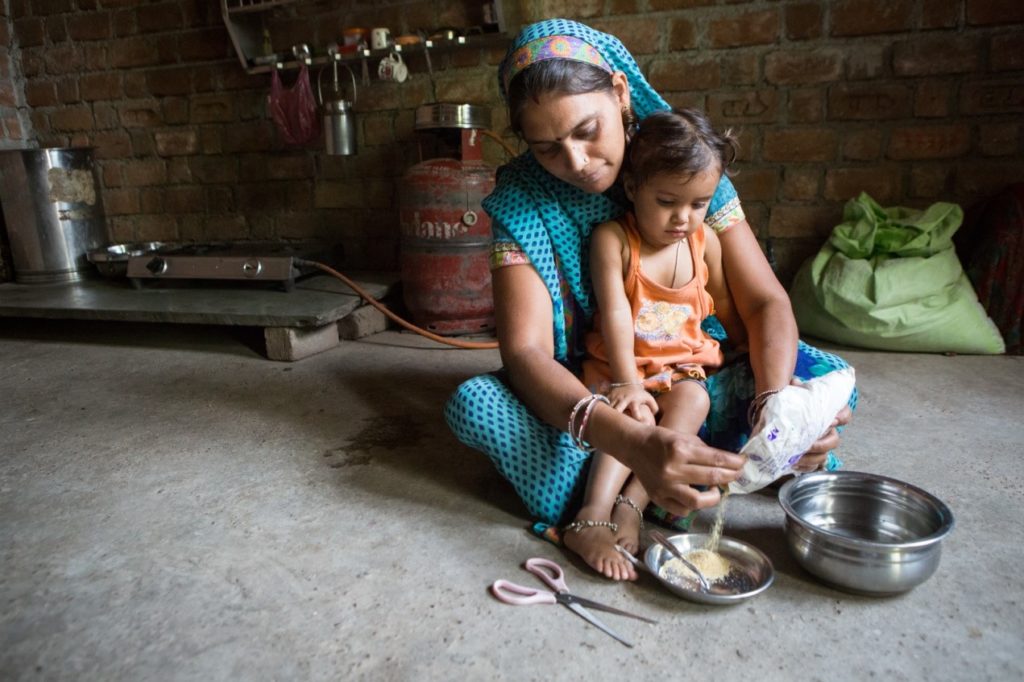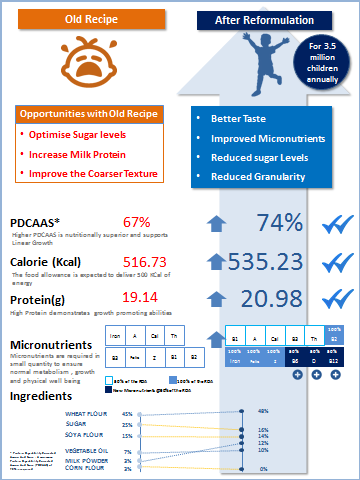Children sit in a circle in the relative coolness of the village Anganwadi center (a courtyard shelter set-up by the government to provide basic health care and nutrition services in Indian villages), eating their lunch of potato curry and roti. Later in the day, mothers will arrive to pick up Take-Home Rations (THR) from the same Anganwadi center for their younger children who don’t attend pre-school. THR is a pre-processed packet of powdered nutritional supplements specially formulated for children six months to three years old, as well as pregnant and lactating women and adolescent girls.
In July, three new THR recipes were introduced across the state of Madhya Pradesh. The children’s supplements now include more protein and micronutrients, have significantly less sugar than the old recipes and cost only about two rupees more to produce for a week’s portion. These food supplements will reach 3.5 million children to help break the deadly cycle of malnutrition before it starts.
Both the hot-cooked meals and THR are provided, with support from the Indian government, under one of the world’s largest supplementary nutrition programs. They form a core component of the Integrated Child Development Scheme (ICDS), India’s flagship program for infant and young child health, nutrition and development.

A mother prepares the improved THR formulation for her child.
The ICDS has been running for over 30 years and has played a pivotal role in arresting malnutrition rates across the country. However, there is still more to be done. Nationally, based on the National Health and Family Welfare 2015-16 report, 38 percent of children under the age of five are stunted and 36 percent are underweight. Madhya Pradesh is one of the biggest states in the country, with over 74 million people, and it carries the third highest burden of malnutrition, with 42 percent of children under the age of five stunted and 43 percent underweight according to the NFHS Report 2015-16. Stunting starts early in life – the first 1,000 days from conception to the age of two – and seriously impacts cognitive functions and weakens the immune system. Compounding this is anemia, a blood condition that results from too little iron in the diet, and which can be particularly dangerous for pregnant women. Over 53 percent of women between the ages of 15 and 49 in Madhya Pradesh suffer from anemia according to the same NFHS Report. These two conditions, malnutrition and anemia, form a deadly inter-generational cycle: a malnourished child is more likely to become anemic as a teenager and then as a pregnant woman, who is more likely to deliver an underweight infant who grows into a malnourished child.
In 2016, CHAI, with support from the IKEA Foundation, partnered with the Madhya Pradesh government to reduce the burden of both malnutrition and anemia in the state. Ensuring children have enough nutritious food to eat was critical to changing those statistics and breaking the malnutrition cycle. Improving the quality and nutritional density of the existing THR was an obvious yet transformational intervention that was prioritized after mutual agreement. CHAI, based on its previous experience of a similar recipe reformulation project in the state of Andhra Pradesh, then worked closely with the National Institute of Nutrition and supported the Department of Women and Child Development to begin reformulating THR recipes for children with the necessary modifications.
The most significant alterations made to the recipes were as follows:
-Reduction in the sugar content by 9 percent. The sugar percentage has been brought down from 25 percent to a 16 percent in the recipe. This modification ensures that most of the calorific value of the recipe is drawn not from sugar but from the core ingredient, wheat.
-Milk powder content was at a mere 3 percent. This shot up to 12 percent in the new recipe. The increase in milk powder provides children with the appropriate amount of protein needed for early physical and cognitive development.

An info-graphic elaborating on the changes in the recipe composition.
The new THR recipes cost approximately two rupees more per beneficiary – from including milk protein and micronutrient fortification to improving the taste and texture so children will eat the supplement. The recent increase in the ICDS budget accounted for the increase in the production cost and ensured that the financial bottlenecks of improving the recipes were removed.
This is the first of several joint initiatives with the government of Madhya Pradesh that CHAI, with support from the IKEA Foundation, is working on in 2018 in order to break the cycle of malnutrition in the state.





